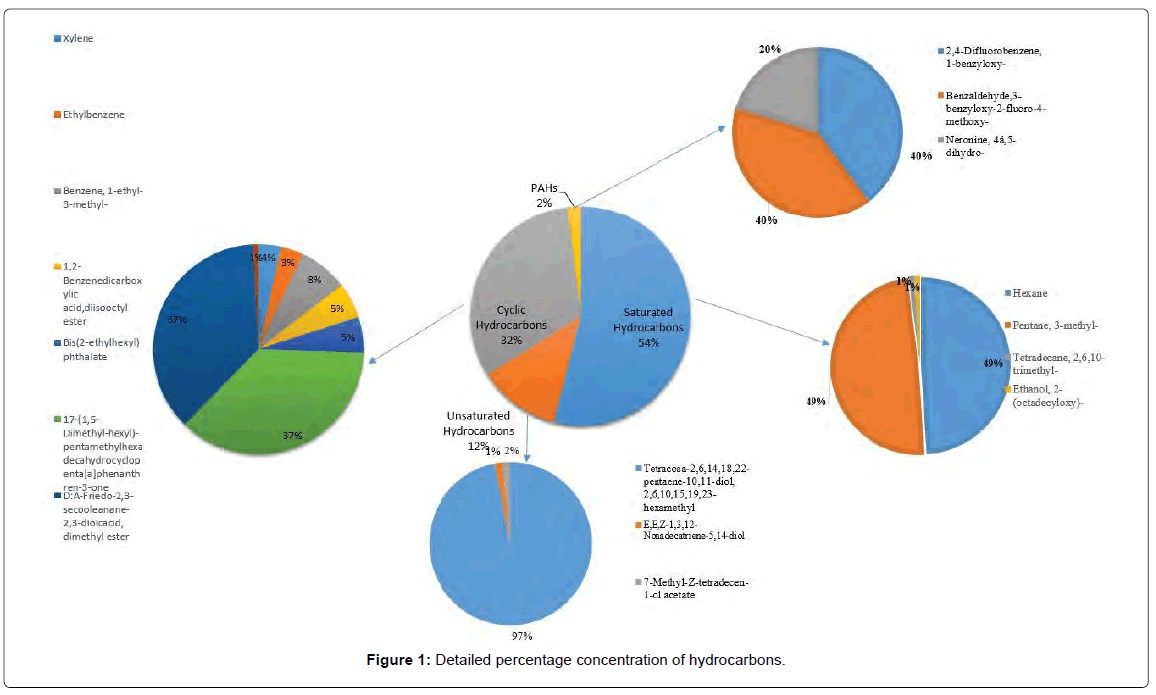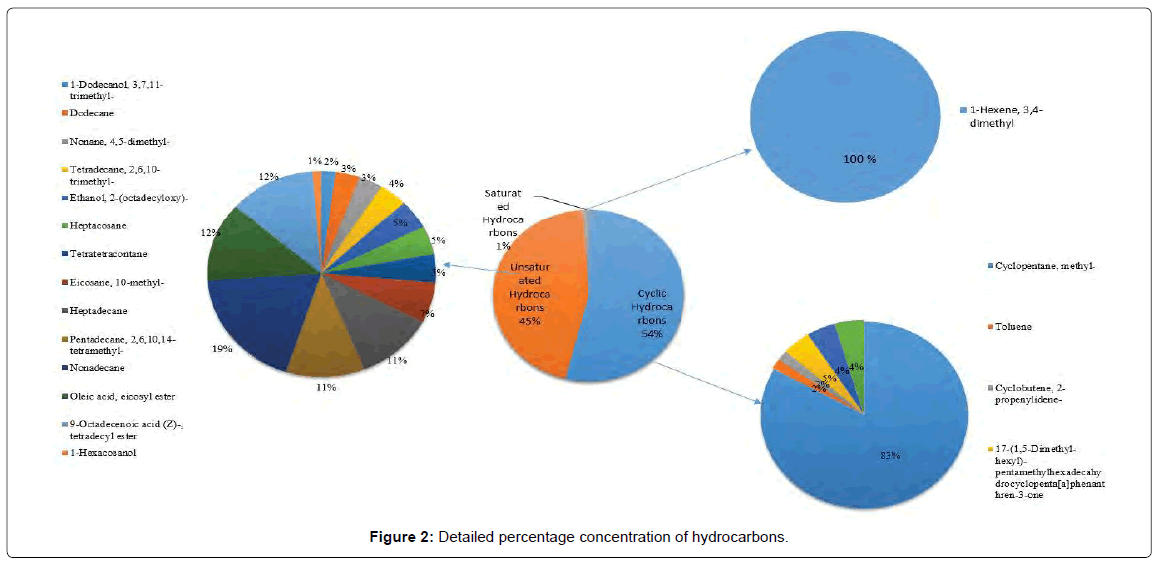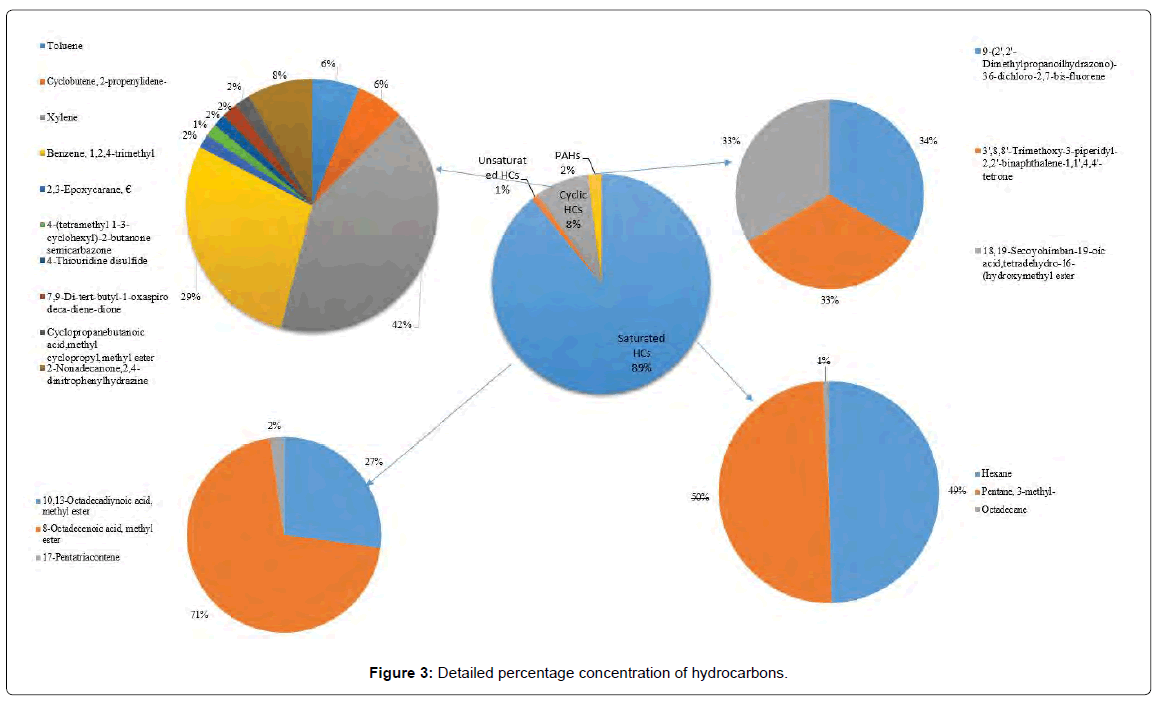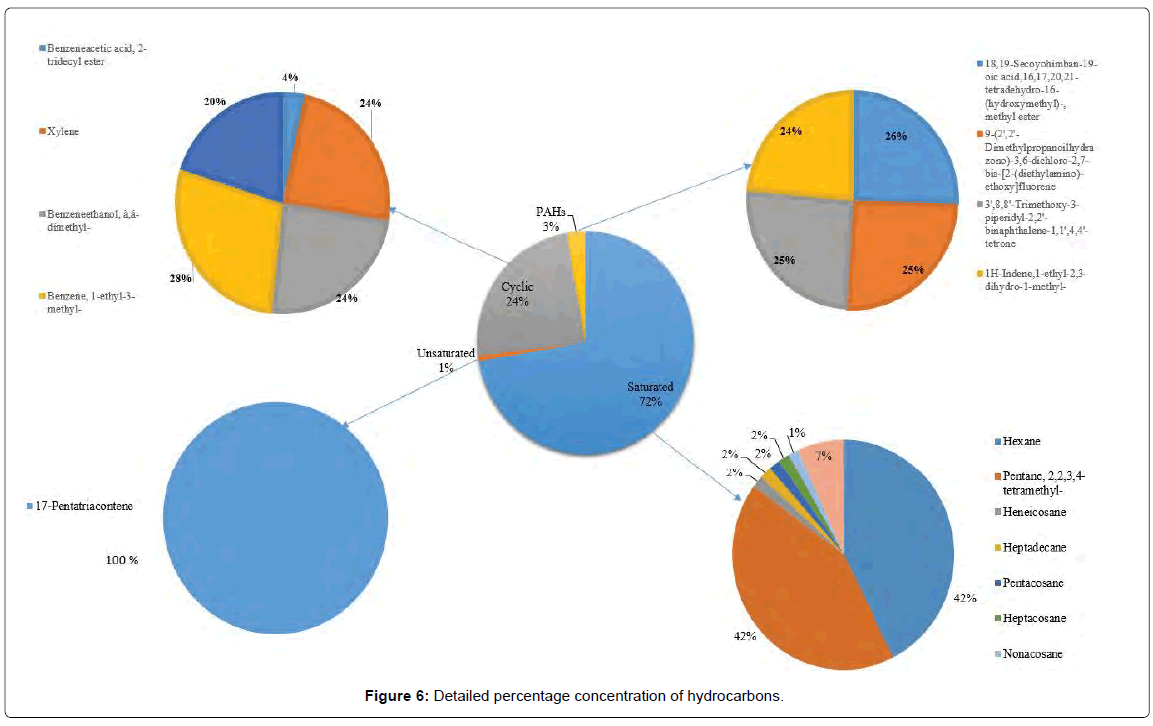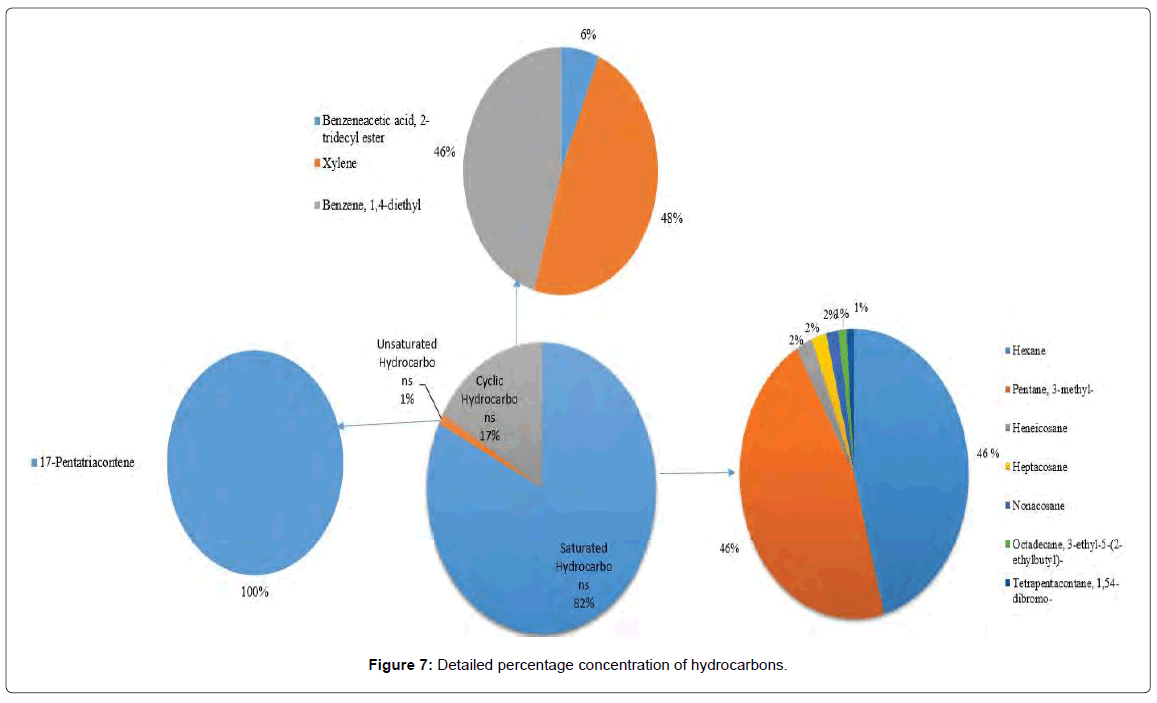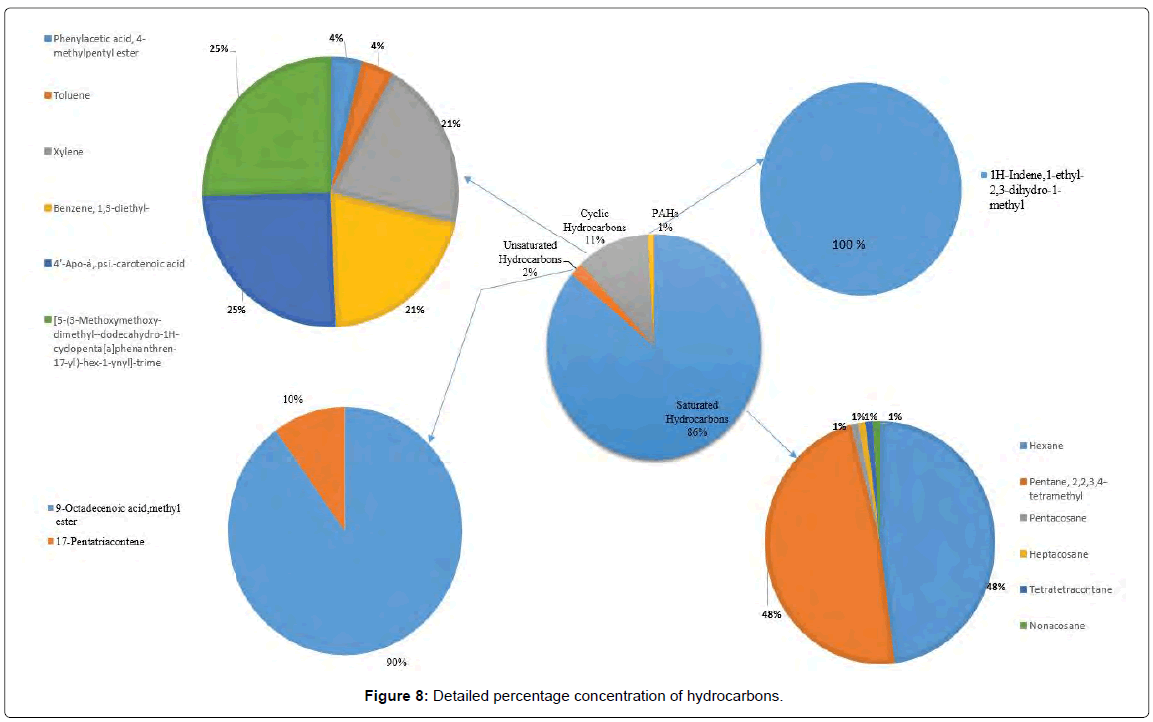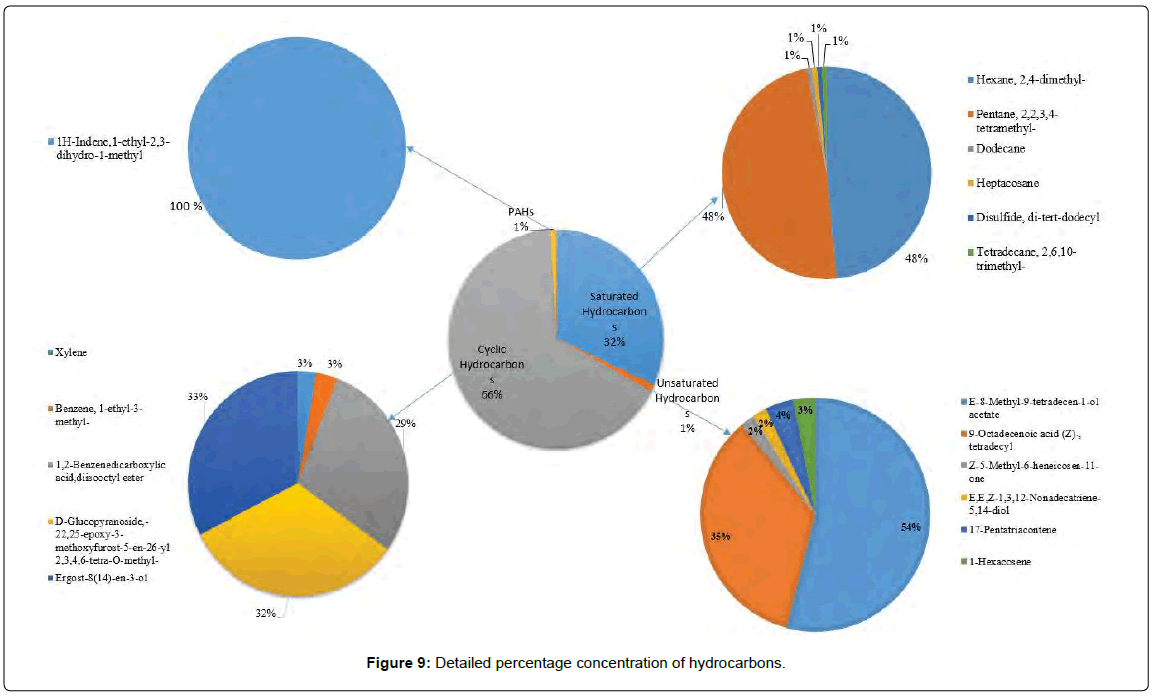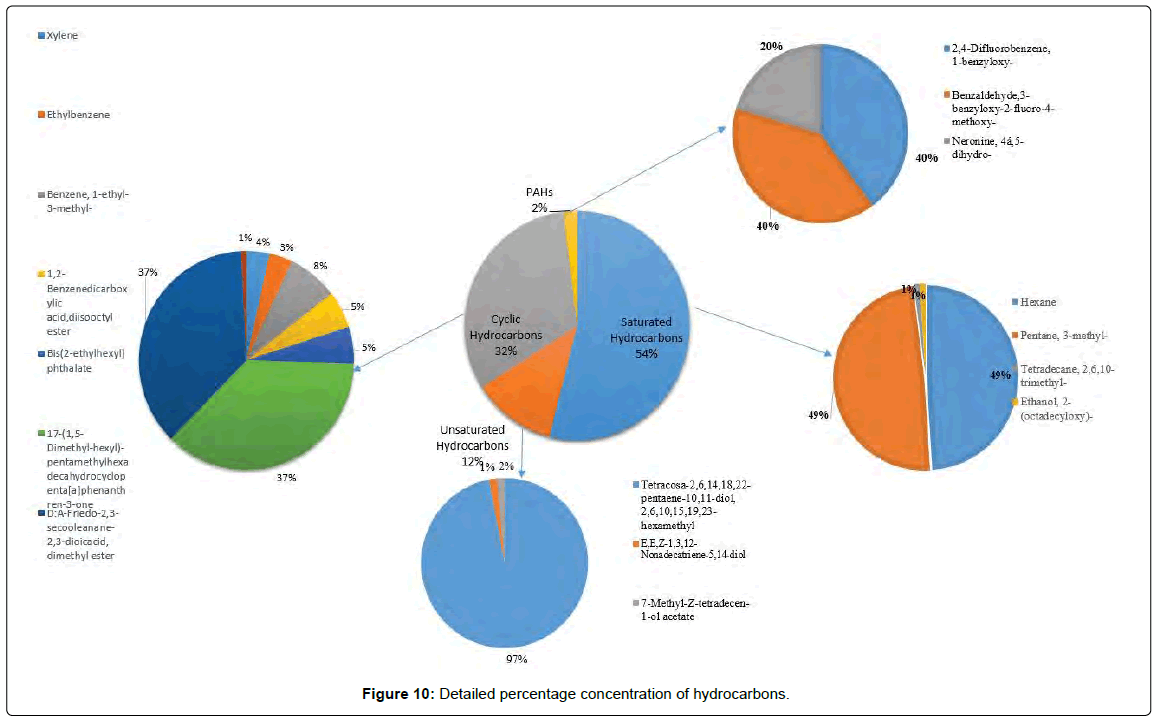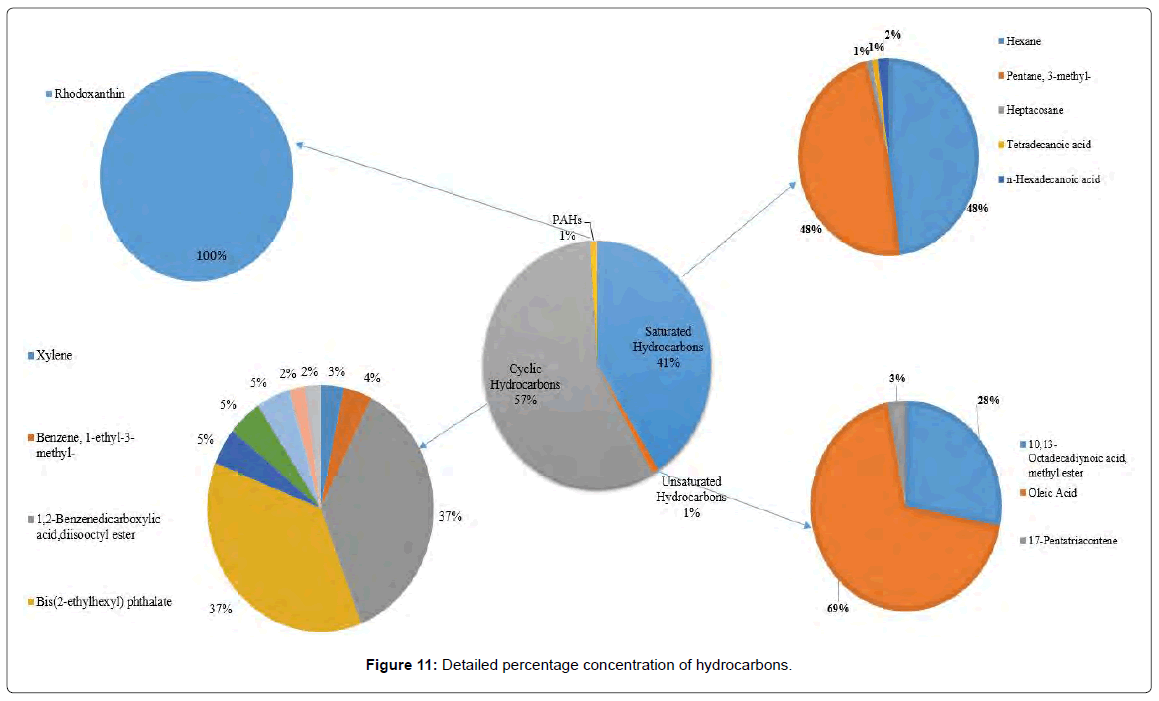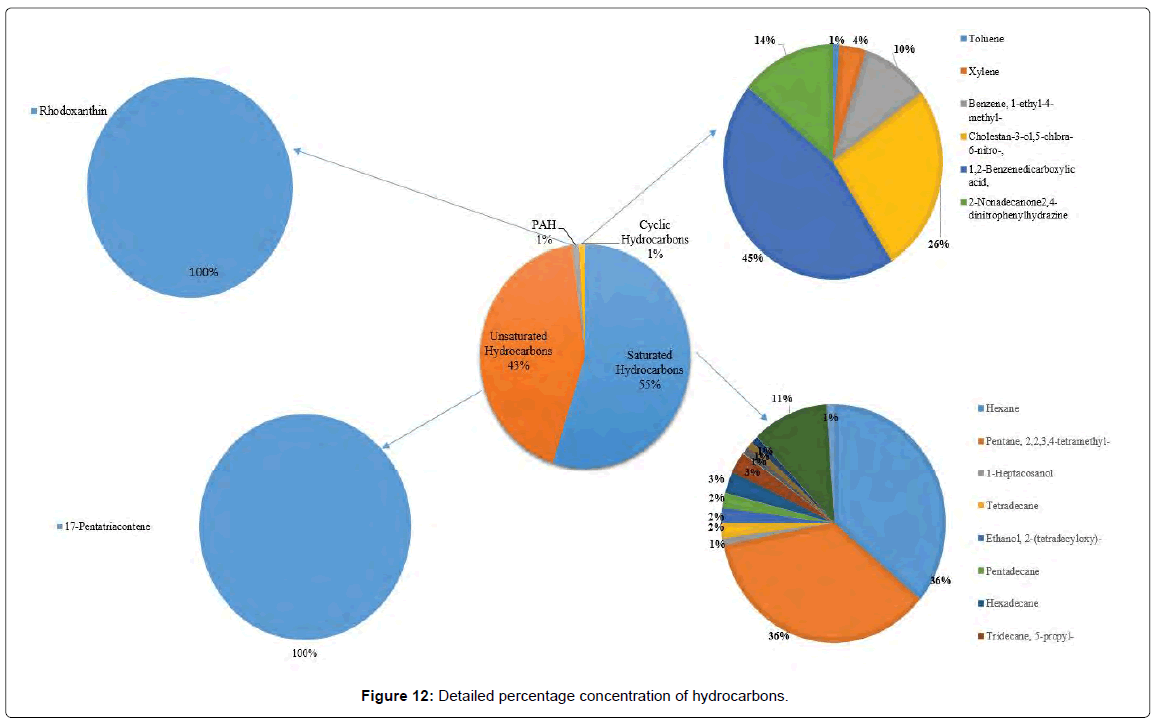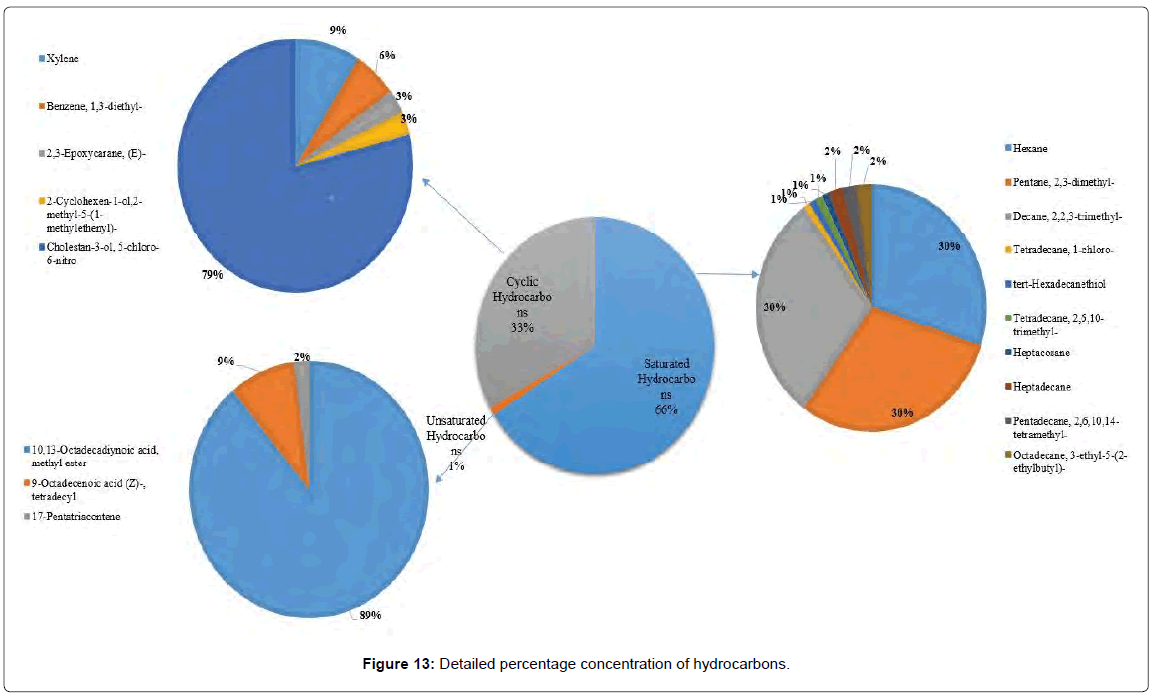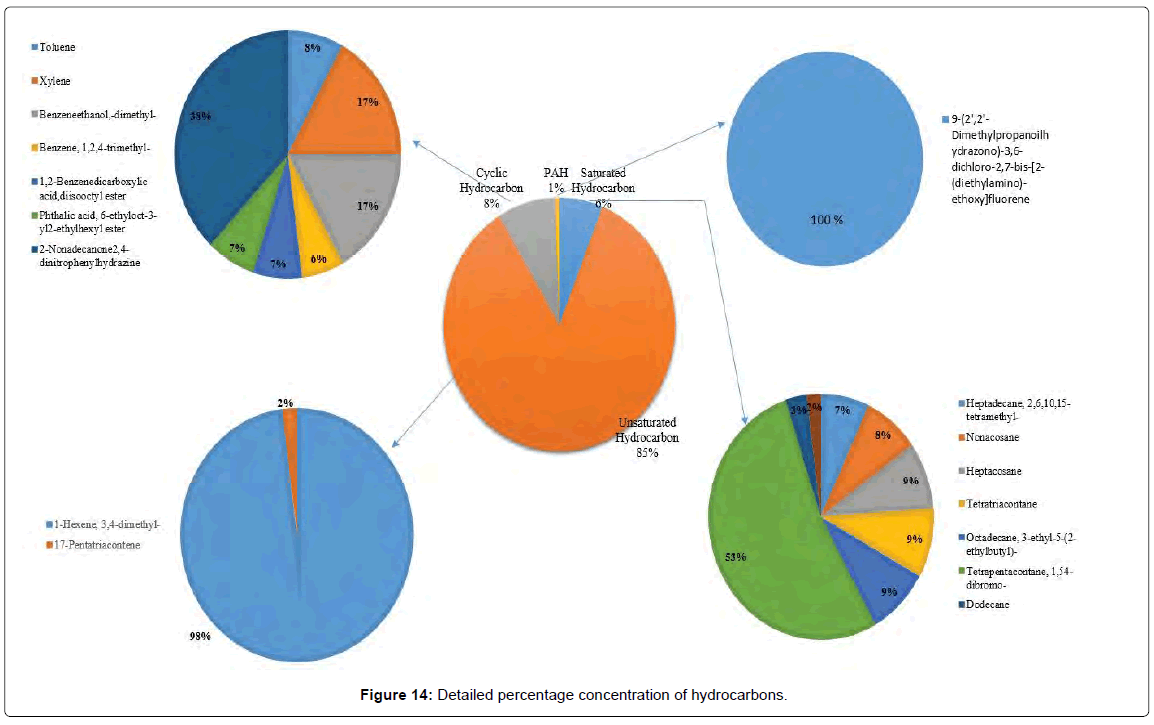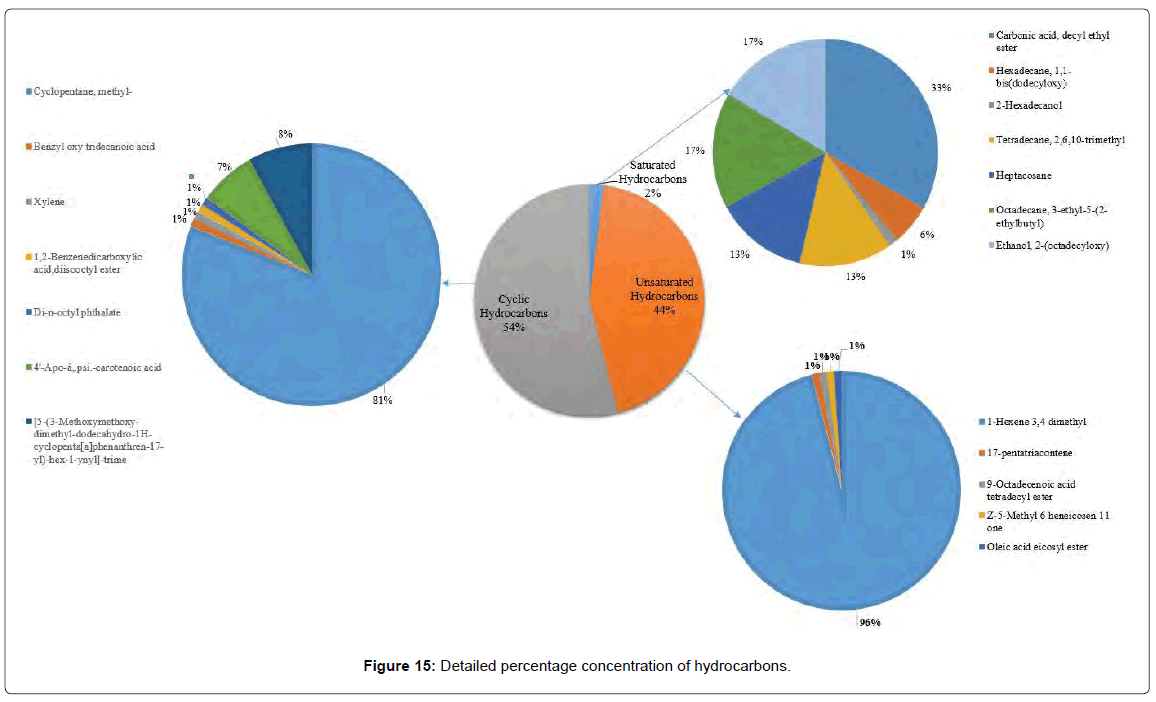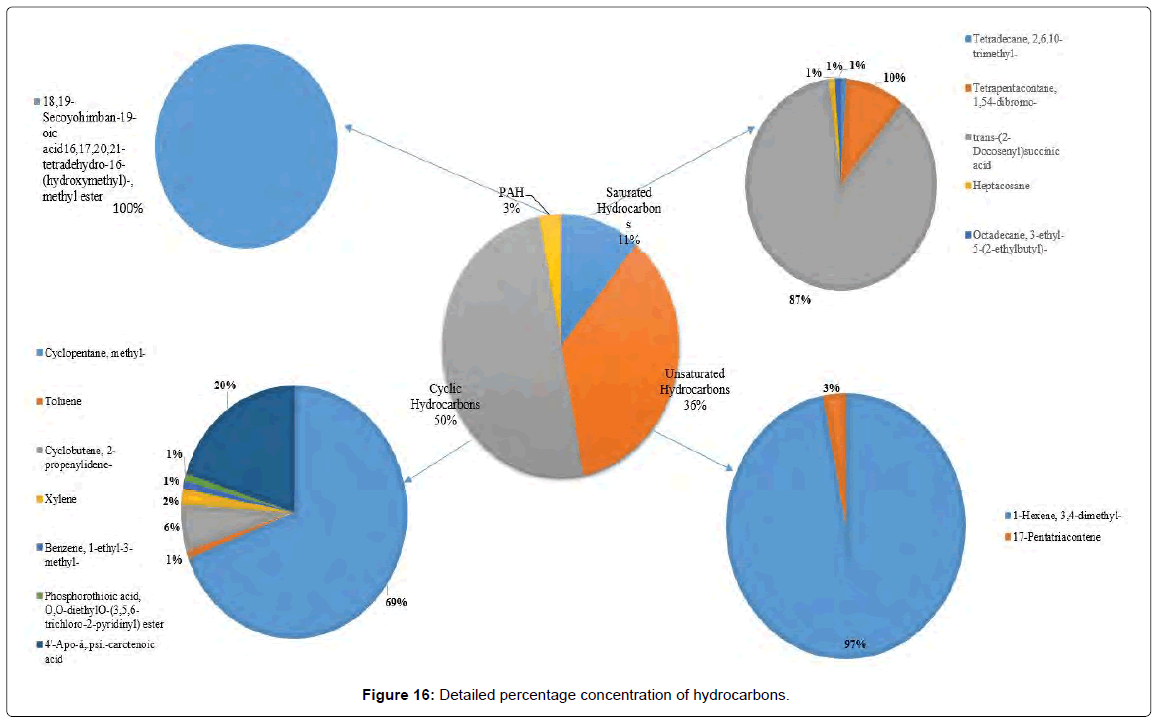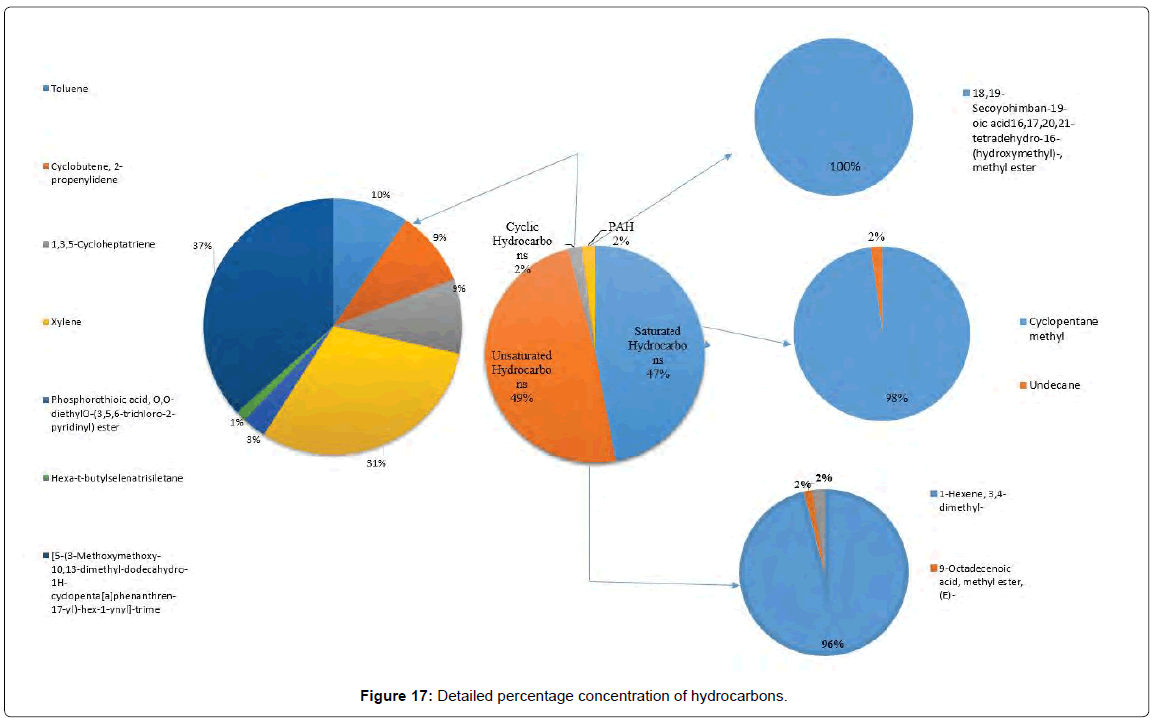Assessment of Total Petroleum Hydrocarbons in Soil from Selected Auto Workshop Areas of Rawalpindi & Islamabad
Received: 03-Nov-2021 / Accepted Date: 17-Nov-2021 / Published Date: 30-Nov-2021
Abstract
Soil of automobile workshop areas was contributing towards environmental deterioration. Present study was conducted to analyze petroleum hydrocarbons in soil of some selected auto workshop areas of Rawalpindi and Islamabad. Soil samples were collected from seventeen different workshop areas of Rawalpindi and Islamabad. Analysis of soil samples was done by means of gas chromatography mass spectrometry (GC-MS) and results were interpreted by area normalization method. Results of the study indicated the presence of saturated hydrocarbons, unsaturated hydrocarbons, cyclic & aromatic hydrocarbons and polycyclic aromatic hydrocarbons. Average percentage concentration of saturated hydrocarbons, cyclic & aromatic hydrocarbons, unsaturated hydrocarbons and polycyclic aromatic hydrocarbons in soil was found to be 37 %, 31%, 20 % and 12 % respectively. Results of the study recommend great caution in handling and disposal of petroleum hydrocarbons at workplace due to probable toxicity of many of the detected substances. Regular monitoring of these petroleum contaminated soil by Pak-EPA was found to be inevitable.
Keywords: Guatambu; Santa Catarina; Tornadoes; Weather Forecasting; Windstorm; Uruguay; Argentina; Rio Grande do Su
Introduction
The environment consisting of air, water, soil, flora, fauna and microbes have great influence on the life of an organism. The quality of life on Earth is directly associated to the quality of Environment. Our environment is going through a lot of natural and artificial changes. Over population, Industrialization, urbanization, improper waste management, tourism, transport activities and unsustainable use of natural resources are chief elements behind environmental problems. Land pollution is the contamination of terrestrial environment or contamination of soil stretching from growing vegetation to groundwater [1]. Soil is the fundamental constituent of life on Earth. Contamination of soil has troubled the life by upsetting the whole ecosystem [2].
Problem Statement
Leading environmental Challenges in Pakistan include contamination of water, soil and air. Chief source of ground water and surface water pollution in Pakistan is direct discharge of waste from various industries and occupational setting into water bodies such as petrochemicals, pesticides, dying chemicals, mining and fertilizers [3]. Most of waste from automobile workshops is dumped on land. Such poor disposal of waste became cause of contamination of soil, water and sediments of the nearby areas with petroleum hydrocarbon [4]. Soil contaminated with petroleum hydrocarbons in occupational setting is thought to be disseminated by dust particles and surface run off leading towards contamination of air and water [5]. In Pakistan, most of the occupational settings are source of innumerable contaminants thus, posing workers at high health risk. Improper handling of petroleum products, usual transportation, accidental spills and leaching of petroleum products are considered to be means of human exposure to chemicals [6]. The condition of automobile workshops in Pakistan was seen to be highly insecure for workers and soil both. In order to access presence of petroleum hydrocarbons in soil of some selected auto workshop areas of Rawalpindi and Islamabad and to study their impacts, study was conducted.
Methods
Methodology used for the study consisted of following steps: (A) Sample Collection (B) Sample Preparation (C) Sample Analysis.
Sample Collection
Random workshop areas of Rawalpindi & Islamabad were selected for composite soil sample collection. Ten composite soil samples were collected from auto workshop areas of Rawalpindi and seven soil samples were collected from Islamabad at the depth of 0-15 cm from five different points at each location and then were mixed to get a composite sample. Samples were collected by using sterilized spade between 12 pm to 5 pm in December 2019 and stored by following standard laboratory procedure. Screening of all soil samples was done through filter paper in order to remove small stones, plant debris and pebbles then soil samples were outspread on paper sheets. Afterward soil samples were air dried at room temperature and then grounded with mortar and pestle. Samples were preserved at temperature of 4oC in refrigerator keeping in view USEPA sampling protocols (Adewoyin et al., 2013; Obini et al., 2013)[2,7].
Sample Preparation
In the process of sample preparation, about 1 g of soil sample was taken in a beaker weighed by using electrical balance. Beaker was washed every time with distilled water and then oven dried before use.10 ml of water was added in the weighed soil sample and stirred well in a beaker for 10 to 15 minutes. Then, about 20 ml of n-hexane was added to the solution and mixed rigorously. After addition of n-hexane 2-3 drops of HCl was added to the solution to lower down the PH of solution to 2. The prepared solution was shifted to a separatory funnel (250 ml) and shaken for about 5 minutes which caused separation of hydrocarbons from soil. The process was repeated three times. Then, 5 g of dry sodium sulphate was added in the separated solution in order to remove extra water. Sample was placed in water bath for evaporation of n-hexane until 1 to 2 ml of solution was left behind in the beaker. Removal of excess water from extracts was ensured. About 10 ml of solvent n-hexane was used to rinse the beaker for elution of hydrocarbons. The extracts were then transferred in eppendorf tube using 0.22 micro meter syringe filter later on these prepared soil samples were analyzed for determination of petroleum hydrocarbons by using gas chromatography mass spectrometry (GC-MS) for identification and assessment of contaminated soil samples [8].
Sample Analysis
Results of the GC-MS were interpreted from chromatograms. A thermo scientific (GC-MS) DSQ, model number DSQ 2 Thermo Scientific Column TR-5MS GC Focus Series was used with initial temperature of 50°C hold for 1 minute and then temperature was increased to 330°C at the rate of 25°C per minute for 15 minutes. The samples were injected in the splitless mode with the flow rate of 1.2 ml/min. The initial column temperature was 4°C and gradually raised from 120°C to 160°C and finally 300°C at the rate of 25°C/min, 10°C/ min and 5°C/min respectively. Injection volume of extracts in GC port was one microliter 1.00 μl at the temperature of 280 °C. Helium gas was used as carrier gas due to its environmental friendly nature at flow rate of 1.2 ml/min. Total run time was 11.6 minute. Additional gas chromatography and mass spectrometry (GC-MS) operating conditions were done as stated by instrument’s operating instruction manual. GC-MS conditions were in compliance with the US-EPA standard protocols. Riplib and mainlib mass spectral library was used to know the presence of hydrocarbons in the sample on the basis of their mass to charge (m/z) ratio in the form of chromatogram [8,9].
Results and Discussion
By employing area normalization method analyzed soil samples were compiled and presented in the form of pie charts. The summary of all types of compounds detected in soil samples are classified into four groups i.e. polycyclic aromatic hydrocarbons (PAHs), aromatic & cyclic hydrocarbons (ACHs), unsaturated and saturated hydrocarbons detail of their respective elements percentage concentration are given (Table 1.1, 1.2, 1.3 and 1.4) respectively.
| Category | Sample (%) | ||||||||||||
|---|---|---|---|---|---|---|---|---|---|---|---|---|---|
| Polycyclic Aromatic Hydrocarbons (PAHs) | 1 | 3 | 4 | 5 | 6 | 8 | 9 | 10 | 11 | 12 | 14 | 16 | 17 |
| 18,19-Secoyohimban-19-oic acid,16,17,20,21-tetradehydro-16-(hydroxymethyl)-, methyl ester | 50 | 33 | 26 | 100 | 100 | ||||||||
| 9-(2',2'-Dimethylpropanoilhydrazono)-3,6-dichloro-2,7-bis-[2-(diethylamino)-ethoxy]fluorene | 50 | 34 | 37 | 25 | 100 | ||||||||
| 3',8,8'-Trimethoxy-3-piperidyl-2,2'-binaphthalene-1,1',4,4'-tetrone | 33 | 38 | 25 | ||||||||||
| 1H-Indene, 2,3-dihydro-4,7-dimethyl | 100 | 24 | |||||||||||
| 1H-Indene,1-ethyl-2,3-dihydro-1-methyl- | 25 | 100 | 100 | ||||||||||
| 2,4-Difluorobenzene, 1-benzyloxy- | 40 | ||||||||||||
| Benzaldehyde,3-benzyloxy-2-fluoro-4-methoxy- | 40 | ||||||||||||
| Neronine,-dihydro | 20 | ||||||||||||
| Rhodoxanthin | 100 | 100 | |||||||||||
Table 1.1: Summary of Percentage concentration of polycyclic aromatic hydrocarbons in all soil samples.
| Category | Sample (%) | ||||||||||||||||
|---|---|---|---|---|---|---|---|---|---|---|---|---|---|---|---|---|---|
| Aromatic and Cyclic Hydrocarbons | 1 | 2 | 3 | 4 | 5 | 6 | 7 | 8 | 9 | 10 | 11 | 12 | 13 | 14 | 15 | 16 | 17 |
| Cyclopentane, methyl- | 96 | 83 | 81 | 69 | |||||||||||||
| Toluene | 2 | 2 | 6 | 4 | 4 | 1 | 8 | 1 | 10 | ||||||||
| Xylene | 1 | 42 | 16 | 23 | 24 | 48 | 21 | 3 | 4 | 3 | 4 | 9 | 17 | 1 | 2 | 30 | |
| Benzene, 1-ethyl-3-methyl- | 1 | 17 | 28 | 3 | 8 | 4 | 1 | ||||||||||
| Benzene, 1,2,4-trimethyl | 29 | 6 | |||||||||||||||
| 2-Nonadecanone,2,4-dinitrophenylhydrazine | 8 | 30 | 2 | 14 | 38 | ||||||||||||
| 1,2-Benzenedicarboxylic acid | 3 | 45 | |||||||||||||||
| Benzene, 1,3-diethyl | 13 | 21 | 6 | ||||||||||||||
| 1,2-Benzenedicarboxylic acid,diisooctyl ester | 3 | 29 | 5 | 37 | 7 | 1 | |||||||||||
| [5-(3-Methoxymethoxy-10,13-dimethyl-dodecahydro-1H-cyclopenta[a]phenanthren-17-yl)-hex-1-ynyl]-trime | 20 | 25 | 8 | 37 | |||||||||||||
| Benzene, 1,4-diethyl- | 46 | ||||||||||||||||
| 4'-Apo-á,.psi.-carotenoic acid | 25 | 5 | 7 | 20 | |||||||||||||
| Bis(2-ethylhexyl) phthalate | 5 | 37 | |||||||||||||||
| Cholestan-3-ol,5-chlora-6-nitro-, | 26 | 79 | |||||||||||||||
Table 1.2: Summary of Percentage concentration of cyclic & aromatic hydrocarbons in all soil samples.
| Category | Sample (%) | ||||||||||||||||
|---|---|---|---|---|---|---|---|---|---|---|---|---|---|---|---|---|---|
| Unsaturated Hydrocarbons | 1 | 2 | 3 | 4 | 5 | 6 | 7 | 8 | 9 | 10 | 11 | 12 | 13 | 14 | 15 | 16 | 17 |
| E-8-Methyl-9-tetradecen-1-ol acetate | 54 | ||||||||||||||||
| 9-Octadecenoic acid (Z)-, tetradecyl ester | 2 | 90 | 35 | 9 | 1 | 2 | |||||||||||
| 10-Octadecenoic acid, methyl ester | 2 | 64 | |||||||||||||||
| 17-Pentatriacontene | 93 | 2 | 100 | 36 | 100 | 100 | 10 | 4 | 3 | 100 | 2 | 2 | 1 | 3 | |||
| 10,13-Octadecadiynoic acid, methyl ester | 27 | 28 | 89 | ||||||||||||||
| 1-Hexene, 3,4-dimethyl | 100 | 98 | 96 | 96 | |||||||||||||
| 8-Octadecenoic acid, methyl ester | 71 | ||||||||||||||||
| 1 hexene dimethyl | 97 | ||||||||||||||||
| Oleic Acid | 69 | ||||||||||||||||
| Tetracosa-2,6,14,18,22-pentaene-10,11-diol, 2,6,10,15,19,23-hexamethyl | 97 | ||||||||||||||||
Table 1.3: Summary of Percentage concentration of unsaturated hydrocarbons in all soil samples.
| Category | Sample (%) | ||||||||||||||||
|---|---|---|---|---|---|---|---|---|---|---|---|---|---|---|---|---|---|
| Saturated Hydrocarbons | 1 | 2 | 3 | 4 | 5 | 6 | 7 | 8 | 9 | 10 | 11 | 12 | 13 | 14 | 15 | 16 | 17 |
| Hydroperoxide, hexyl | 90 | ||||||||||||||||
| Tetrapentacontane, 1,54-dibromo | 9 | 7 | 7 | 11 | 53 | 2 | |||||||||||
| Tetradecane, 2,6,10-trimethyl | 4 | 1 | 1 | 1 | 13 | 1 | |||||||||||
| Ethanol, 2-(octadecyloxy) | 5 | 1 | 2 | 17 | |||||||||||||
| Heptacosane | 5 | 2 | 1 | 2 | 2 | 1 | 1 | 1 | 9 | 13 | 1 | ||||||
| Heptadecane | 11 | 2 | 2 | 1 | 2 | 14 | |||||||||||
| Pentadecane, 2,6,10,14-tetramethyl | 11 | 2 | 14 | ||||||||||||||
| Pentane, 3-methyl | 50 | 42 | 49 | 48 | |||||||||||||
| Borinic acid, diethyl | 47 | ||||||||||||||||
| Hexane | 49 | 48 | 48 | 42 | 42 | 48 | 49 | 48 | 36 | 30 | |||||||
| Pentane, 2,2,3,4-tetramethyl | 49 | 42 | 48 | 48 | 36 | ||||||||||||
| Octadecane, 3-ethyl-5-(2-ethylbutyl)- | 48 | 1 | 2 | 9 | 17 | 1 | 1 | ||||||||||
| Pentane, 2,3-dimethyl | 30 | ||||||||||||||||
| Decane, 2,2,3-trimethyl | 30 | ||||||||||||||||
| Carbonic acid, decyl ethyl ester | 33 | ||||||||||||||||
| Hexadecane, 1,1-bis(dodecyloxy) | 6 | 22 | |||||||||||||||
| trans-(2-Docosenyl)succinic acid | 87 | ||||||||||||||||
Table1.4: Summary of Percentage concentration of saturated hydrocarbons in all soil samples.
Each sample study was done separately for all the four compounds divisions and shown in pie charts below sample wise. As figure 1 shows detail of soil sample no 1 taken from the workshop of Rawalpindi where percentage concentration of saturated, unsaturated, cyclic and polycyclic aromatic hydrocarbons are 48.16, 4.30, 45.53661, and 1.99 respectively. Two polycyclic aromatic hydrocarbons (PAHs) were detected in sample no 1. 18,19-Secoyohimban-19- oicacid,16,17,20,21-tetradehydro-16-(hydroxymethyl), methyl ester and 9-(2,2-dimethylpropanoilhydrazono)-3,6-dichloro-2,7-bis- (diethylamino)-ethoxy fluorine having percentage concentration of 49.91993 and 49.91993 respectively as shown in Figure 1.
Figure 2 shows total petroleum hydrocarbons in soil sample no 2 taken from another workshop area of Rawalpindi. No polycyclic aromatic hydrocarbon was detected, only saturated, unsaturated and cyclic compounds with shown percentage in pie chart were detected.
Similarly results of all the 17th samples are shown below with percentage concentration of four types of hydrocarbons are shown in Figure 3 to 17 below.
Another recent research also reported identification of petroleum hydrocarbons in soil contaminated with engine oil similar to the results of soil samples of the present research study. The study revealed the presence of unsaturated hydrocarbon, monocyclic aromatic and polycyclic compounds. The detected hydrocarbons have the potential to accumulate in soil and food chains leading to serious health hazards [10]. Studies have documented automobile workshops as a major source of injecting hydrocarbons into the terrestrial ecosystem. These petroleum hydrocarbons being an integral constituent of gasoline and engine oil may accumulate in soil and living organisms inhabiting soil [11]. Polycyclic aromatic hydrocarbons were considered to be the prime cause of skin and lung cancer among people working in vehicle inspection and maintenance related work in Beijing [12]. Polycyclic aromatic hydrocarbons in the soil in another research study showed carcinogenicity in humans on direct contact. Leaching of this petroleum hydrocarbon contaminated soil exhibited a probable threat to ground water quality [13]. A research study reported the presence of aliphatic saturated, aliphatic unsaturated and polycyclic aromatic hydrocarbons from GC-MS analysis of soil and water samples. The detected compounds showed ill effect on the soil and water quality of the study area [14]. The risk of cardiovascular diseases among workers working in automobile repair, maintenance, and manufacturing workshops was also found high as a consequence to daily exposure to benzene toluene and xylene [15]. Saturated hydrocarbons including tetradecane and hexadecane being an important constituent of fuel were documented as hazardous soil contaminants [16]. Enhanced exposure of workers to aromatic hydrocarbons in automobile workshops showed a reduction in their hemoglobin level and red blood cells in a research study conducted in Rawalpindi [6].
Conclusion
• Analysis of hydrocarbons was done by using gas chromatography mass spectrometry (GC-MS). Results of the study were interpreted by area normalization method. The results showed average percentage concentration of hydrocarbons in soil was 36.6%, 20.2%, 30.7% and 12.5% for saturated, unsaturated, cyclic & aromatic and polycyclic aromatic hydrocarbons respectively.
• Maximum percentage concentration of saturated hydrocarbons was found at point 1 with percentage concentration of 90 %, while maximum percentage concentration of unsaturated hydrocarbons was found at point 2, 4, 6, 7 and 12 with percentage concentration of 100 %. Maximum percentage concentration of cyclic and aromatic hydrocarbons was also found at point 1 with percentage concentration of 96 % and among polycyclic aromatic hydrocarbons no polycyclic aromatic hydrocarbon was detected at point 2, 7, 13 and 15 and maximum percentage concentration of polycyclic aromatic hydrocarbons was found at point 4, 8, 9, 11, 12, 16 and 17 with 100%.
• The study suggests that proper management and monitoring strategies should be developed by Pak-EPA in order to prevent contamination of soil of auto workshop areas of twin cities.
Recommendations
(1) Permissible limits must be set by Pak-EPA for discharge of petroleum hydrocarbons in soil.
(2) Petroleum hydrocarbon contaminated soil needed to be regularly traced and monitored.
(3) Provisions regarding safe secure use of petroleum and its products should be implemented at workplaces.
(4) Specific regulations for the health and safety of the workers should be made.
(5) Safety measures must be followed by workers to protect themselves from any disease or accidents
(6) Training and awareness of workers should be made mandatory by keeping in view occupational health and environmental protection.
References
- Adewoyin OA, Hassan AT, Aladesida A (2013) The impacts of auto-mechanic workshops on soil and groundwater in Ibadan metropolis. Afr J Environ Sci Technol 7: 891-898.
- Adewole MB, Uchegbu LU (2010) Properties of Soils and Plants Uptake within the Vicinity of Selected Automobile Workshops in Ile-Ife Southwestern, Nigeria. Ethopian J Environ Stud Manage 3.
- Waseem A, Arshad J, Iqbal F, Sajjad A, Mehmood Z, et al. (2014) Pollution Status of Pakistan: A Retrospective Review on Heavy Metal Contamination of Water, Soil, and Vegetables. BioMed Res Int Pp:1-29.
- Lwegbue CMA, Williams ES, Nwajei GE (2008) Characteristic level of Total Petroleum Hydrocarbon in Soil Profiles of Automobile Mechanic Waste Dumps. Int J Soil Sci 3: 48-51.
- Din UI, Rashid A, Mahmood T, Khalid A, (2013) Effect of land use activities on PAH contamination in urban soils of Rawalpindi and Islamabad, Pakistan. Environ Monit Assess 185: 8685-8694.
- Kamal A, Malik NR (2012) Hematological evidence of occupational exposure to chemicals and other factors among auto-repair workers in Rawalpindi, Pakistan. Osong Public Health Res Perspect 3: 229-238.
- Obini U, Okafor CO, Afiukwa JN (2013) Determination of levels of polycyclic aromatic hydrocarbons in soil contaminated with spent motor Engine oil in Abakaliki Auto-Mechanic Village. J Appl Sci Environ Manage 17: 169-175.
- Richter EB (2000) Extraction of hydrocarbon contamination from soils using accelerated solvent extraction. J Chromatogr 874: 217-224.
- Dong DC, Chen FC, Chen WC (2012) Determination of Polycyclic Aromatic Hydrocarbons in Industrial Harbor Sediments by GC-MS. Int J Environ Res 9: 2175-2188.
- Chinenye NO (2020) Identification of polyaromatic compounds in spent oil contaminated soil. J Mater Sci Res Rev 4: 1-11.
- Biose E, Ogbewi E (2017) Assessment of BTEX concentration in soils and earthworm (Aporrectodea Longa) from two automobile workshops in Benin City, Southern Nigeria. Sci Afr 18:195-200.
- Li P, Kong S, Geng C, Han B, Lu B, et al. (2013) Health risk assessment for vehicle inspection workers exposed to airborne polycyclic aromatic hydrocarbons (PAHs) in their work place. Environ Sci Process Impacts 15: 623-632.
- Wang X, Miao Y, Zhang Y, Li Y, Wu M, et al. (2013) Polycyclic aromatic hydrocarbons (PAHs) in urban soils of the megacity Shanghai: Occurrence, source apportionment and potential human health risk. Sci Total Environment 447: 80-89.
- Garima M, Trivedi RK (2016) Recent analytical study of affluent-petrochemicals on the environment and plausible effects of such chemicals on the human health around newly established oil refinery, Bina, Sagar district, MP India. Int J Environ Sci 6: 610-617.
- Zhou H, Jiang L, Mai S, Zhang J, Wang Z, et al. (2019) Analysis of the cardiovascular effects on workers expose to occupational benzene-toluene-xylene and noise in a painting workshop of an automobile company. Chin J Ind Hyg Occup Dis 37: 280-283.
- Stroud JL, Paton GI, Semple KT (2007) Microbe-aliphatic hydrocarbon interactions in soil: implications for biodegradation and bioremediation. J Appl Microbiology 102: 1239-1253.
Citation: Shafqat S, Khan SA, Shafqat S (2021) Assessment of Total Petroleum Hydrocarbons in Soil from Selected Auto Workshop Areas of Rawalpindi & Islamabad. J Earth Sci Clim Change 12: 589.
Copyright: © 2021 Shafqat S, et al. This is an open-access article distributed under the terms of the Creative Commons Attribution License, which permits unrestricted use, distribution, and reproduction in any medium, provided the original author and source are credited.
Select your language of interest to view the total content in your interested language
Share This Article
Recommended Journals
Open Access Journals
Article Usage
- Total views: 2199
- [From(publication date): 0-2021 - Nov 08, 2025]
- Breakdown by view type
- HTML page views: 1618
- PDF downloads: 581

